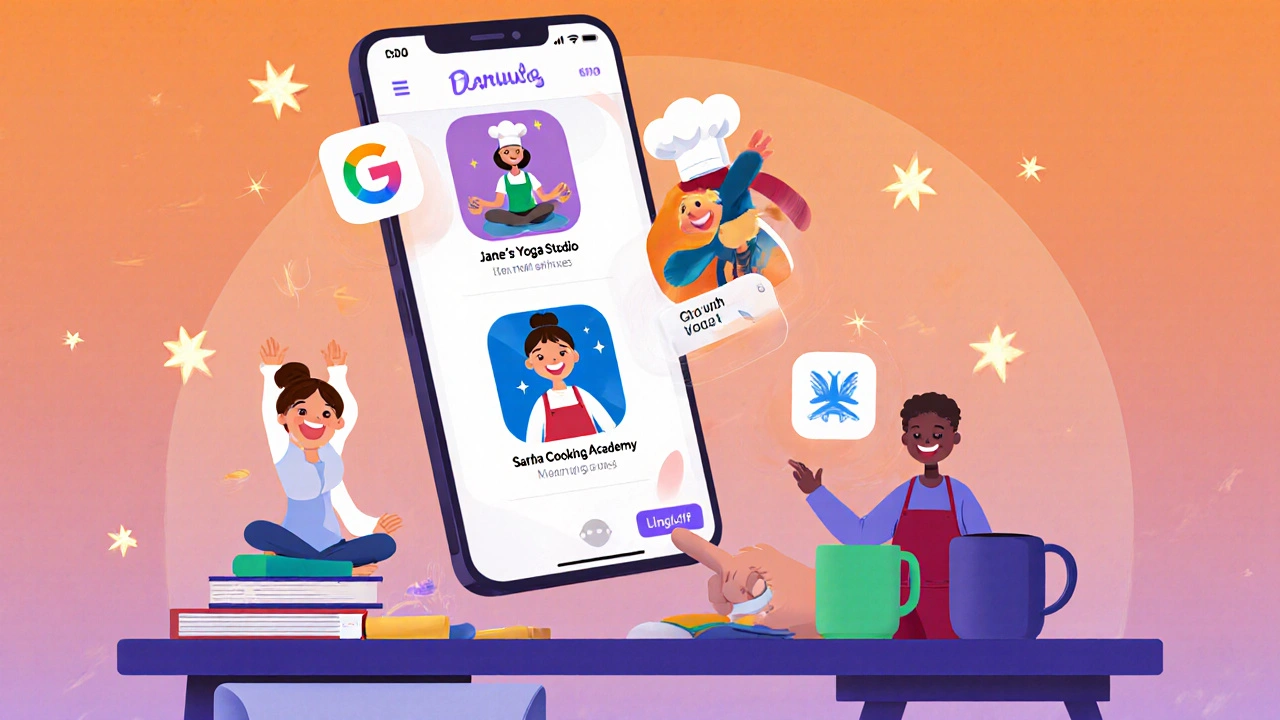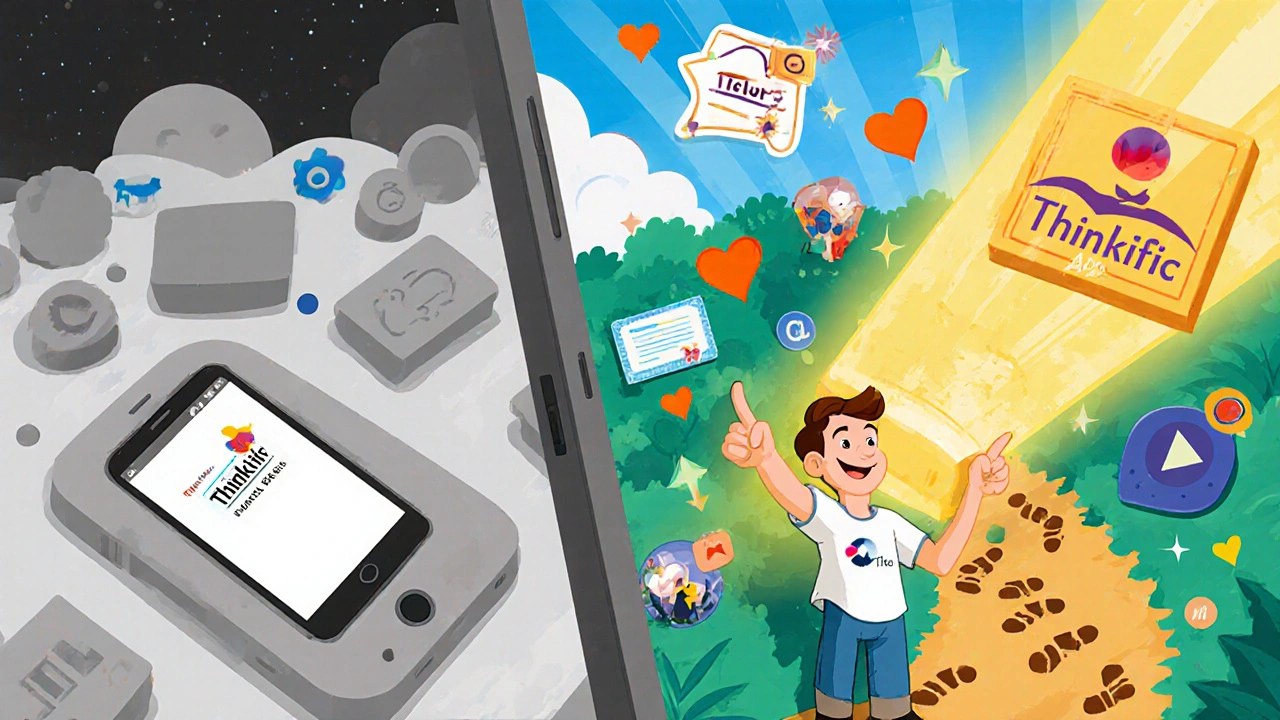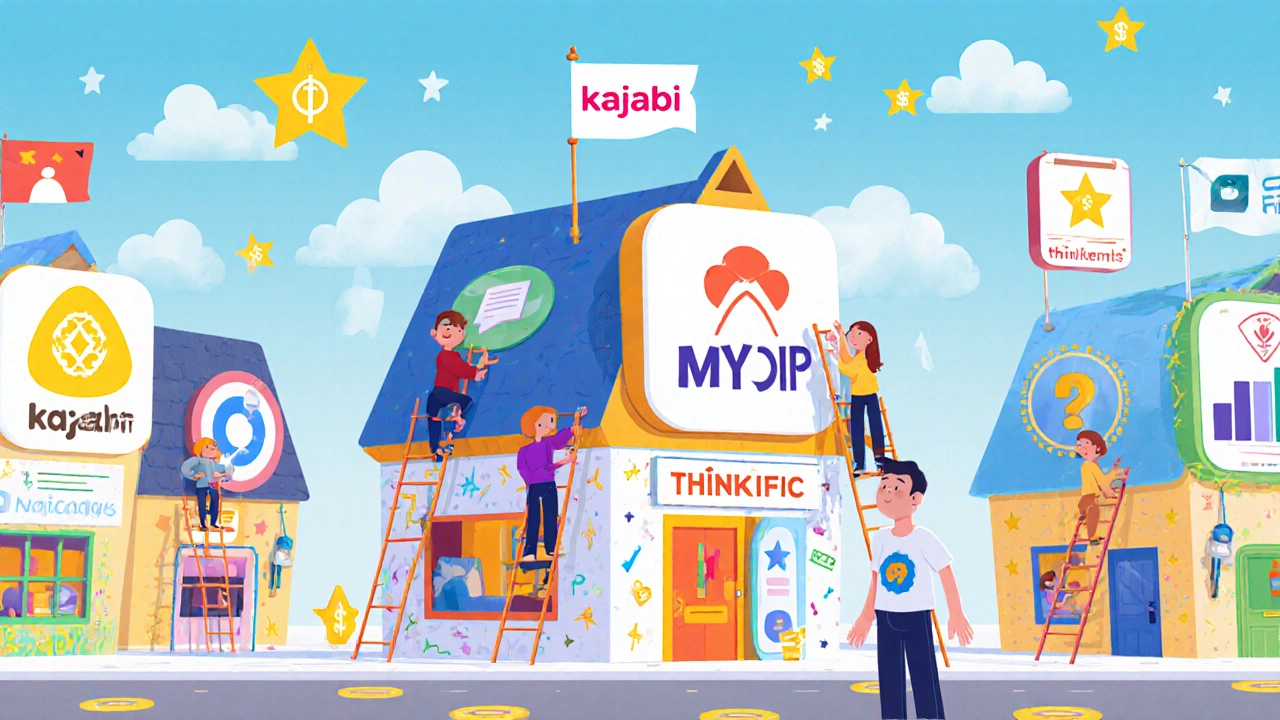White-Label Mobile Apps for Course Platforms: Build Your Branded iOS and Android App
 Oct, 1 2025
Oct, 1 2025
Want to launch your own online course platform with a fully branded mobile app-no coding needed? You’re not alone. Thousands of coaches, educators, and course creators are ditching generic app templates and choosing white-label mobile apps that let them put their logo, colors, and name on a real iOS and Android app. This isn’t just about looking professional. It’s about control, trust, and keeping learners inside your ecosystem instead of sending them to third-party app stores with competing courses.
What Exactly Is a White-Label Mobile App?
A white-label mobile app is a pre-built app that you can rebrand completely. Think of it like buying a plain white t-shirt-you paint your logo on it, change the color, and sell it as your own. In the world of course platforms, this means you get a working iOS and Android app built by someone else, but you own the branding, the user experience, and the customer relationship.
Most white-label apps for education come with core features: video lessons, quizzes, progress tracking, certificates, push notifications, and in-app messaging. The platform handles the backend: app store submissions, updates, server maintenance, and security. You focus on teaching.
Companies like Kajabi, Thinkific, Podia, and LearnDash offer white-label mobile apps as part of their higher-tier plans. These aren’t just web wrappers. They’re native apps built with Swift for iOS and Kotlin for Android, meaning they load fast, work offline, and feel like apps people actually use every day.
Why Bother With a Branded App When You Have a Website?
Here’s the truth: people don’t open websites on their phones the way they used to. They open apps. According to 2025 data from App Annie, 90% of mobile time is spent inside apps-not browsers. If your course is only accessible through a mobile browser, you’re losing engagement.
A branded app increases retention. Push notifications remind learners about new lessons. The app icon sits on their home screen, making your course top-of-mind. When someone sees your app icon labeled “Jane’s Yoga Studio” instead of “Thinkific,” they feel like they’re part of your community, not a customer of a third-party platform.
Branding also builds trust. A learner is more likely to pay $299 for a course when the app looks like it was made just for you-not a generic template with a watermark. Studies from Harvard Business Review show branded apps have 3x higher completion rates than browser-based courses.
What Features Should You Look For?
Not all white-label apps are equal. Here’s what actually matters when you’re comparing platforms:
- Native performance: Does it run smoothly without lag? Avoid apps built with WebView (web pages inside an app). Look for apps built with Swift and Kotlin.
- Offline access: Can learners download lessons and watch them without Wi-Fi? Essential for travelers, commuters, and people in low-connectivity areas.
- Custom branding: Can you change the logo, color scheme, fonts, splash screen, and even the app name? Some platforms lock you into their default theme.
- Push notifications: Can you send targeted alerts? (e.g., “Your weekly meditation module is ready.”)
- Analytics: Do you see how many people open the app daily, which lessons are watched most, and where people drop off?
- App store submission: Does the platform handle publishing to Apple App Store and Google Play? Or do you need a developer account and technical know-how?
Platforms like Kajabi and Podia include all of this in their Pro plans. Others charge extra or require third-party integrations. Always ask: “Can I publish under my own developer account?” If the answer is no, you’re stuck with their brand visibility.

Top 3 Platforms That Offer White-Label Mobile Apps in 2025
After testing over a dozen platforms, these three stand out for ease of use, branding control, and app quality:
| Platform | App Type | Branding Control | Offline Access | App Store Submission | Starting Price (USD/month) |
|---|---|---|---|---|---|
| Kajabi All-in-one platform for course creators, coaches, and digital product sellers | Native iOS and Android | Full: logo, colors, name, icons | Yes | Yes (uses your developer account) | $149 |
| Podia Simple platform for selling courses, memberships, and digital downloads | Native iOS and Android | Full: logo, colors, name | Yes | Yes (uses your developer account) | $89 |
| Thinkific Flexible course platform with custom branding and app integration | Native iOS and Android | Full: logo, colors, name, splash screen | Yes | Yes (uses your developer account) | $119 |
Kajabi leads in features but costs the most. Podia is the most affordable and still gives you full control. Thinkific offers the most customization options if you want to tweak the app’s layout or add custom fields.
What’s missing? Platforms like Teachable and Udemy don’t offer true white-label apps. They give you a mobile website, not a native app. You can’t change the app name or remove their branding. That’s not white-label-that’s a fallback.
How to Get Started Without a Developer
You don’t need to hire a developer. Here’s how to launch your branded app in under 2 weeks:
- Choose a platform that includes white-label mobile apps (Kajabi, Podia, or Thinkific).
- Sign up for their highest plan that includes the app feature.
- Upload your logo, brand colors, and app name in the dashboard.
- Connect your Apple Developer account (costs $99/year) and Google Play Developer account (one-time $25 fee).
- Let the platform generate the app files and submit them to the stores.
- Wait 3-7 days for approval from Apple and Google.
- Send the app link to your students. Done.
Most platforms guide you through each step. The hardest part? Paying for the developer accounts. But that’s your asset-you own it forever. Even if you switch platforms later, you keep the app name and store presence.

Common Mistakes to Avoid
Here’s what goes wrong when people skip the details:
- Using a free plan: Free tiers don’t include apps. You’ll get a web link that looks like a mobile site-not a real app.
- Ignoring app store rules: Apple rejects apps that are just web wrappers. Make sure your platform uses native code.
- Not testing on real devices: Emulators lie. Test the app on an iPhone and Android phone you know your students use.
- Forgetting push notifications: If you don’t use them, you lose 70% of daily engagement. Set up automated reminders for new lessons and deadlines.
- Thinking it’s a one-time setup: Apps need updates. Check your platform’s changelog every quarter. New features like dark mode or in-app payments often roll out.
Who Benefits Most From a Branded App?
Not everyone needs one. But if any of these sound like you, you’re a perfect fit:
- You charge $100+ per course and want to reduce churn.
- You have recurring students who take multiple courses.
- You offer live coaching or community features.
- You’re building a long-term brand, not just selling a one-off course.
- You want to collect emails and data directly-no middleman.
Coaches, fitness trainers, language tutors, and certification programs see the biggest ROI. One yoga instructor in Austin doubled her student retention after launching her branded app. She started sending weekly push reminders: “Your 10-minute morning flow is ready.” Completion rates jumped from 42% to 81%.
What’s Next? Your App, Your Rules
White-label mobile apps are no longer a luxury. They’re a baseline for serious course creators in 2025. If your competitors have apps and you don’t, you’re already behind.
Start small. Pick one platform. Launch your app with five core lessons. Add push notifications. Watch how often students open it. You’ll see the difference in engagement within days.
Your brand deserves its own app-not someone else’s template.
Can I use my own app name on a white-label mobile app?
Yes. Platforms like Kajabi, Podia, and Thinkific let you choose your own app name-like “Sarah’s Cooking Academy” instead of “Thinkific App.” The app store listing will show your name, not the platform’s. You just need to own the Apple and Google developer accounts.
Do I need a developer account to publish the app?
Yes. Apple charges $99/year for an iOS Developer account. Google charges $25 one-time for a Google Play account. These are mandatory. The course platform helps you generate the app files, but you must submit them under your own account to keep full control and branding.
Can learners download lessons without Wi-Fi?
Yes, if the platform supports offline access. Kajabi, Podia, and Thinkific all let learners download video lessons, PDFs, and quizzes to watch or use without an internet connection. This is critical for travelers, students in rural areas, or anyone with spotty service.
Are white-label apps secure for student data?
Yes, if you choose a reputable platform. These platforms use enterprise-grade encryption, comply with GDPR and FERPA, and handle data storage securely. Your students’ emails, payment info, and progress data are protected. Avoid platforms that don’t mention security certifications.
What happens if I cancel my course platform subscription?
Your app stays live on the app stores-you own the developer accounts. But you’ll lose access to updates, new features, and backend support. If you stop paying, the app won’t crash, but it won’t get new lessons or fixes either. Plan ahead: export your content and consider migrating to another platform if needed.
Sally McElroy
October 31, 2025 AT 09:22Let me be clear: if you're not building a branded app, you're not building a business-you're renting a digital shed on someone else's property. Thinkific doesn't own your students, but their watermark does. And that's not branding, that's digital serfdom.
Destiny Brumbaugh
November 1, 2025 AT 06:29bro why are we paying 150 bucks a month just to put our logo on an app?? i can make a website for 20 bucks on wix and slap a button that says "open in app". this whole thing is a scam to make us pay more for stuff we already own
Sara Escanciano
November 1, 2025 AT 12:47People who use free plans or don't own their developer accounts are asking for trouble. Apple doesn't care if you're a "small creator"-they'll reject your app for being a "web wrapper" and you'll lose months of work. This isn't advice-it's survival.
Elmer Burgos
November 3, 2025 AT 04:10Just wanted to say thanks for laying this out so clearly. I was on the fence about switching from Teachable but after reading this I realized I was just avoiding the real work. I signed up for Podia yesterday and uploaded my logo. Feels good to have my own app icon on my phone now
Jason Townsend
November 4, 2025 AT 12:21you think this is about branding wait till you find out apple and google are tracking every tap in your app and selling it to advertisers they own the data not you the platform is just the middleman and theyll sell you out the second they get a better deal
Antwan Holder
November 5, 2025 AT 09:01I remember when I first launched my app. The first push notification I sent out was "Your daily meditation is ready." I sat there staring at my phone for 47 minutes waiting for a notification to pop up. When it did... I cried. Not because I was emotional. But because I finally felt like I mattered. Not as a vendor. Not as a brand. As a human who created something real.
Angelina Jefary
November 6, 2025 AT 10:12"Kajabi leads in features but costs the most." No. Kajabi leads in features and charges the correct price for enterprise-grade infrastructure. "Most affordable" is not a virtue if it sacrifices security. And "white-label" is not a buzzword-it's a legal term. Stop misusing it.
Jennifer Kaiser
November 8, 2025 AT 09:49I've been teaching yoga online for six years. I started with YouTube, then moved to Teachable, then to Podia. The moment I launched my branded app, my students stopped asking "how do I get to the course?" and started saying "I saw your app popped up today." That shift-from transaction to presence-is everything. This isn't tech. It's belonging.
TIARA SUKMA UTAMA
November 10, 2025 AT 00:09do you need an app? i think just text your students. free. easy. no fees. no apps. just you and them.
Jasmine Oey
November 10, 2025 AT 23:23Honestly, if you're still using a web-based platform in 2025, you're not just behind-you're culturally irrelevant. I mean, come on. We live in a world where even my 72-year-old aunt has a custom app for her knitting circle. If your students aren't opening an app with your name on it, you're not a teacher-you're a content vendor. And nobody pays $299 to be a content vendor.
Marissa Martin
November 12, 2025 AT 04:39I'm not against apps. I just think we're ignoring the human cost. Every time someone downloads an app, they're giving up a little more of their attention. Is that really worth it? Maybe we should be building quieter spaces-not more notifications.